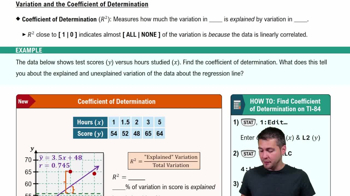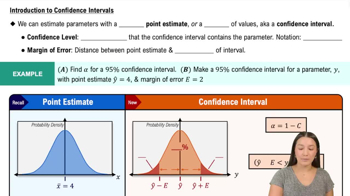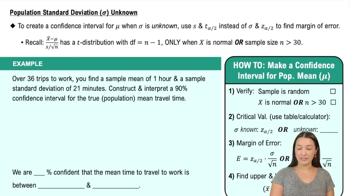Mean IQ of Data Scientists See the preceding exercise, in which we can assume that sigma=15 for the IQ scores. Data scientists are a group with IQ scores that vary less than the IQ scores of the general population. Find the sample size needed to estimate the mean IQ of data scientists, given that we want 98% confidence that the sample mean is within 2 IQ points of the population mean. Does the sample size appear to be practical?
Table of contents
- 1. Intro to Stats and Collecting Data1h 14m
- 2. Describing Data with Tables and Graphs1h 55m
- 3. Describing Data Numerically2h 5m
- 4. Probability2h 16m
- 5. Binomial Distribution & Discrete Random Variables3h 6m
- 6. Normal Distribution and Continuous Random Variables2h 11m
- 7. Sampling Distributions & Confidence Intervals: Mean3h 23m
- Sampling Distribution of the Sample Mean and Central Limit Theorem19m
- Distribution of Sample Mean - Excel23m
- Introduction to Confidence Intervals15m
- Confidence Intervals for Population Mean1h 18m
- Determining the Minimum Sample Size Required12m
- Finding Probabilities and T Critical Values - Excel28m
- Confidence Intervals for Population Means - Excel25m
- 8. Sampling Distributions & Confidence Intervals: Proportion1h 12m
- 9. Hypothesis Testing for One Sample3h 29m
- 10. Hypothesis Testing for Two Samples4h 50m
- Two Proportions1h 13m
- Two Proportions Hypothesis Test - Excel28m
- Two Means - Unknown, Unequal Variance1h 3m
- Two Means - Unknown Variances Hypothesis Test - Excel12m
- Two Means - Unknown, Equal Variance15m
- Two Means - Unknown, Equal Variances Hypothesis Test - Excel9m
- Two Means - Known Variance12m
- Two Means - Sigma Known Hypothesis Test - Excel21m
- Two Means - Matched Pairs (Dependent Samples)42m
- Matched Pairs Hypothesis Test - Excel12m
- 11. Correlation1h 6m
- 12. Regression1h 50m
- 13. Chi-Square Tests & Goodness of Fit1h 57m
- 14. ANOVA1h 57m
7. Sampling Distributions & Confidence Intervals: Mean
Confidence Intervals for Population Mean
Problem 7.2.26b
Textbook Question
Mean Pulse Rate of Females Data Set 1 “Body Data” in Appendix B includes pulse rates of 147 randomly selected adult females, and those pulse rates vary from a low of 36 bpm to a high of 104 bpm. Find the minimum sample size required to estimate the mean pulse rate of adult females. Assume that we want 99% confidence that the sample mean is within 2 bpm of the population mean.
b. Assume that sigma=12.5 bpm, based on the value of s=12.5 bpm for the sample of 147 female pulse rates.
 Verified step by step guidance
Verified step by step guidance1
Step 1: Identify the formula for determining the minimum sample size required to estimate the population mean. The formula is: , where is the sample size, is the z-score corresponding to the confidence level, is the population standard deviation, and is the margin of error.
Step 2: Determine the values given in the problem. The confidence level is 99%, so the z-score corresponding to this confidence level is approximately 2.576. The population standard deviation is given as 12.5 bpm, and the margin of error is 2 bpm.
Step 3: Substitute the known values into the formula. Replace with 2.576, with 12.5, and with 2 in the formula: .
Step 4: Simplify the numerator by squaring the z-score and the standard deviation. Then, simplify the denominator by squaring the margin of error.
Step 5: Divide the simplified numerator by the simplified denominator to calculate the minimum sample size. If the result is not a whole number, always round up to the nearest whole number, as sample size must be an integer.
 Verified video answer for a similar problem:
Verified video answer for a similar problem:This video solution was recommended by our tutors as helpful for the problem above
Video duration:
1mPlay a video:
Was this helpful?
Key Concepts
Here are the essential concepts you must grasp in order to answer the question correctly.
Sample Size Determination
Sample size determination is a statistical process used to calculate the number of observations needed to achieve a desired level of precision in estimating a population parameter. In this context, it involves using the desired confidence level and margin of error to ensure that the sample mean is a reliable estimate of the population mean.
Recommended video:
Guided course

Coefficient of Determination
Confidence Interval
A confidence interval is a range of values, derived from a sample, that is likely to contain the population parameter with a specified level of confidence. In this case, a 99% confidence level indicates that if we were to take many samples, approximately 99% of the calculated intervals would contain the true population mean.
Recommended video:

Introduction to Confidence Intervals
Standard Deviation and Population Variance
Standard deviation is a measure of the amount of variation or dispersion in a set of values. In this scenario, the given standard deviation (sigma = 12.5 bpm) is crucial for calculating the sample size, as it reflects the variability in pulse rates among adult females, influencing the precision of the estimate.
Recommended video:

Population Standard Deviation Unknown

 4:48m
4:48mWatch next
Master Population Standard Deviation Known with a bite sized video explanation from Patrick
Start learningRelated Videos
Related Practice
Textbook Question
